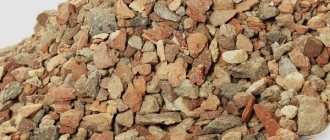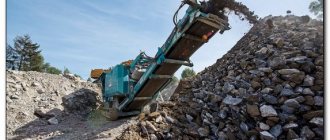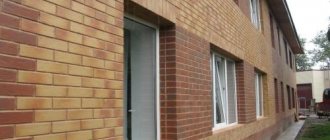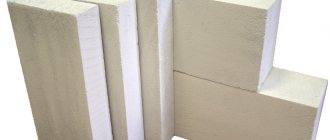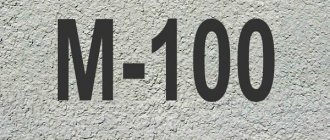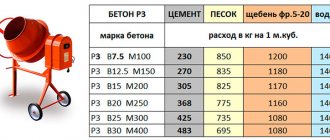Crushed stone is one of the main components of concrete. But how should it be chosen? What size of crushed stone and what rock is best suited for certain jobs? After all, the material has many varieties with different characteristics and prices. In this article we will analyze in detail what large filler you need to buy for various solutions. After reading the text, you will understand where you can save money and where it is better to overpay so that the quality of the final product does not suffer.
But first of all, let’s answer the question - why, in principle, do you need to care about the quality of crushed stone in concrete? Understanding its role in concrete mortar will help you make the right choice.
From the Soil Trucks company you can buy crushed stone for concrete with delivery to your site at the lowest price.
Price for crushed stone for concrete from 490 rubles. for 1m3 Order
Why do you need crushed stone in concrete?
Crushed stone performs several important functions in concrete:
- It is a kind of frame for smaller components (cement, sand or screenings).
- It does not allow a layer of water to form around small particles, which reduces the strength of concrete.
- The uneven surface of crushed stone contributes to its better adhesion to other components. After hardening, the solution turns into a monolith that will not collapse when exposed to loads of any direction.
- Stone allows liquid to pass through much worse than a simple cement-sand mixture. Therefore, its addition also increases the waterproofing properties.
- Thanks to crushed stone, the concrete structure becomes more elastic, cracks do not appear on it, deformation, creep and shrinkage are reduced.
- The most expensive ingredient in concrete is cement. The price of crushed stone is significantly lower. Adding it to concrete saves a lot of money. At the same time, the strength of the building will not decrease, but, on the contrary, will increase.
The higher the characteristics of crushed stone, the higher they are for concrete. But in order for crushed stone to perform its function 100%, it must meet all state standards.
What happens if crushed stone is used incorrectly?
When adding crushed stone, it is important to maintain proportions. If there is too much of it, it does not adhere well to the cement, and the structure easily disintegrates under the influence of loads. The deficiency leads to subsidence and a decrease in the strength of concrete. The optimal amount is 80% of the total volume of the mixture.
If you buy too expensive material for simple work (installing fence posts, pouring the floor in a poultry house), you will overpay. Yes, your building will be strong, but its operating conditions do not require this. And vice versa: if you buy cheap crushed stone for building a house, you will lose even more. Cracks will soon appear on the walls, and the building itself may simply collapse over time.
Before purchasing, be sure to check all supplier certificates. Study the material carefully and check its characteristics. We will tell you about the properties that are important to pay attention to when purchasing crushed stone for concrete in the continuation of the article.
Video description
The video clearly describes the flakiness of crushed stone:
Radioactivity
Few people pay attention to this indicator. It has nothing to do with the technical characteristics of the material. But in modern life, where everyone has become more attentive to their own health, the radioactivity of purchased crushed stone is a very important indicator.
Therefore, we will immediately make a reservation that for residential buildings the radioactivity of any building materials should not exceed 740 Bq/kg. This value can be found in the quality certificate. Therefore, be sure to ask the seller for this document. If it is not there, then think about whether it is worth buying building materials whose quality has not been confirmed by anything.
Checking the radioactivity of crushed stone Source derevyannyydom.ru
What parameters are used to select crushed stone?
So, what are the most important qualities of a material? We have already said above that crushed stone should ensure the strength of concrete and resist subsidence and destruction of buildings.
The most important properties of crushed stone that can provide this function are the following:
- View
- Strength
- Frost resistance
- Fraction
- Flakiness
- Adhesion
Next we will reveal some details.
Our own concrete production and laboratory, as well as a large fleet of equipment guarantee high quality products and accurate delivery times
Concrete - production and delivery
Concrete pumps - rent
Read more about us here
7 904 179–31–56
Valentin Yurievich Shvets
Director of BetonStroy
Type of crushed stone
Concrete is made from the following types of crushed stone:
- Amphibolite
- Secondary
- gravel
- Granite
- Limestone
- Serpentinite
Please note that crushed stone from gabbro, diorite, marble and quartz rocks is not suitable for creating concrete.
Granite crushed stone is considered the highest quality material for creating concrete structures. In terms of characteristics, it is almost as good as amphibolite and serpentinite. But these varieties are expensive. It is advisable to use them only for critical work.
Gravel is obtained from dilapidated rocks. It has lower strength than the previous three types, but the price is low. It is usually used for concrete in regions where there is no high-quality crushed stone. Gravel is suitable for buildings bearing light loads.
Crushed limestone is a fairly popular filler for concrete production. It is great for creating low grades M100 and M150. But it also has different strengths. It largely depends on the composition of the limestone rock and the presence of dolomite impurities.
Strength
This indicator is directly dependent on the type. The most durable crushed stone is from igneous rocks (granite), in second place from metamorphic rocks (serpentinite, amphibolite), and in third place from sedimentary rocks (limestone). Recycled materials have the lowest rates.
The strength of crushed stone affects the grade of concrete. Therefore, you need to choose it taking into account what class of final product you want to receive.
Please take a look at the table below.
Correspondence between crushed stone and concrete grades
| Concrete grade | Crushed stone grade by strength |
| M100 | M600 |
| M200 | M800 |
| M300 | M1000 |
| M400 - M500 | M1200 |
Let's look at the table using specific examples:
- If you want to prepare M100 grade concrete, you need to take crushed stone with a strength rating of M600.
- If you use crushed stone with a strength of M1000 when mixing concrete, you will not be able to get M100 or M500 concrete. In this case, the grade of concrete will be only M300.
As you may have noticed, the strength of concrete is several times lower than that of crushed stone. In addition, the weaker the strength of crushed stone, the lower the grade of concrete. It is impossible to obtain strong, high-grade concrete using crushed stone with a low strength index.
You need to choose crushed stone for concrete based on the work for which it is needed. If you want to fill fence posts with concrete, do not overpay and do not buy M1200 material. This way you will pointlessly increase your spending. It makes no sense to take expensive crushed stone with a strength of M1200 for M200 concrete. And vice versa: do not skimp when it comes to building the foundation of a house, and choose durable materials.
Frost resistance
In cold and temperate climates, frost resistance must be taken into account on any construction site. If this indicator for crushed stone is low, then constant temperature changes from plus to minus can quickly lead to the destruction of the concrete structure.
Frost resistance depends on the type of crushed stone and is directly proportional to its strength. To obtain normal and stable concrete, the coarse aggregate index must be at least F150. From such stone you will get F50 concrete. Granite crushed stone with frost resistance F400 is used to make concrete F300 and higher.
If you are going to prepare a solution for interior finishing or pouring a floor indoors, you do not need to pay special attention to frost resistance. Granite may well be replaced by gravel or limestone. But to fill the foundation and even the path, it is better to use a material that is more resistant to temperature changes. For example, amphibolite instead of limestone or serpentinite instead of gravel.
Crushed stone fraction
The fraction (grain size) affects the quality of concrete no less than the type of crushed stone. Her choice also depends on the intended work.
All factions can be roughly divided into:
- Small (5-20)
- Medium (20-40)
- Large (from 40 mm and above)
The grain sizes of fine fractions range from 5 mm to 20 mm. It is considered the most popular and in demand in construction. Sometimes it is called that - concrete fraction. Due to their size, such stones ideally fill voids in the mixture. They are taken for concrete intended for any work.
Small fractions include:
- 5-10
- 5-20
- 10-15
- 10-20
- 15-20
Grains from 20 mm to 40 mm are considered medium. Concrete prepared with such crushed stone is used in important work: in the construction of foundations, construction of residential buildings, creation of concrete pads under highways and railway tracks.
Grains whose diameter is more than 40 mm can be classified as large.
The following fractions are distinguished here:
- 40-70
- 40-120
- 80-120
This material is used for the construction of industrial facilities and high-rise buildings.
In order for the concrete to be of the highest quality, and the structure to be strong and reliable, when mixing you need to use crushed stone of not one, but several fractions. Let's explain with an example.
As we have already said, crushed stone is a large aggregate in a concrete mixture. The stones are bonded together using cement and water. Fine aggregate (such as sand) fills the remaining voids between the crushed stone. This way you get something like a mosaic, in which there are no empty spaces. However, sometimes either the stones may not fit correctly due to their shape, or there will not be enough sand - then voids cannot be avoided. For this reason, it is better to use not one fraction of crushed stone, but two or three (for example, 5-10, 5-20, 20-40). In this case, when mixing, the mosaic will form best, and the concrete will be the strongest.
Flakiness
We have already mentioned in passing above that the shape of the grains, as well as their size, is also important. It is the shape (or flakiness) that determines how the mosaic will be formed and whether there will be spaces in the concrete structure that are not filled with material.
The ideal grain shape for concrete is cubic. Such stones fit tightly to each other, no voids are formed between them. Cement and sand penetrate well into the cracks and provide optimal adhesion. The quality of the material is worse, in which there are many conical particles. But the worst option is crushed stone with high flakiness.
Flakiness is the number of needle-shaped and lamellar stones in the total mass of crushed stone. In other words, the higher it is, the more irregularly shaped stones there are in the material. Such crushed stone is poorly compacted and large voids form between the grains. As a result, concrete is poorly compacted, quickly deteriorates and loses frost resistance.
In addition to the shape of the grains, it is also worth taking a closer look at their surface. This primarily concerns crushed gravel. Smooth stones do not adhere well to cement, which affects the strength of the final product. Therefore, preference is given to crushed stone with uneven edges.
Adhesion
The adhesive properties of crushed stone is its ability to adhere to cement. It directly depends on the flakiness.
In addition, adhesion is related to the type of rock from which the crushed stone was obtained. This characteristic is higher for materials with a rough surface (granite) and lower for smooth stones (limestone, gravel).
Now you know how the properties of crushed stone affect the concrete material. Next we will talk about which crushed stone to choose for certain brands of concrete and specific work.
Determination of frost resistance
This is a very important indicator, since it affects the overall frost resistance of the concrete stone. If the frost resistance of crushed stone is lower, then the destruction of the entire structure will occur in this zone, that is, when water gets into the pores of grains, it will expand in the cold.
To carry out the tests, two analytical samples are taken from each fraction from 1 to 5 kg, depending on the size of the fraction. Wash and dry. Then placed in water at a temperature of + 20 C, after 48 hours placed in a freezer at a temperature of -18 C, kept for 4 hours and again in water at a temperature of + 20 C.
And so 15 cycles in a row, after which they are placed on a control sieve, on which the samples remained completely until testing and weighed.
After this, the next 25 cycles are carried out and so on. By periodically measuring every 25 cycles, the frost resistance class is determined by weight loss (see table).
| Type of test | Frost resistance grade for crushed stone and gravel | |||||||
| F15 | F25 | F50 | F100 | F150 | F200 | F300 | F400 | |
| Freeze-thaw: | ||||||||
| number of cycles | 15 | 25 | 50 | 100 | 150 | 200 | 300 | 400 |
| weight loss after testing,%, no more | 10 | 10 | 5 | 5 | 5 | 5 | 5 | 5 |
| Saturation in sodium sulfate solution, drying: | ||||||||
| number of cycles | 3 | 5 | 10 | 10 | 15 | 15 | 15 | 15 |
| weight loss after testing,%, no more | 10 | 10 | 10 | 5 | 5 | 3 | 2 | 1 |
Once again I note the importance of such an indicator as frost resistance.
How to choose crushed stone for specific brands of concrete
Which crushed stone should I choose for the M300 grade? What is better to make concrete M200 from, gravel or granite? We have prepared answers to these and similar questions for you. But first, let's note an important detail.
The characteristics of the same material in different deposits may be different. Even within the same quarry, a stone mined in one place may differ from the same material mined 500 meters later. Therefore, for each batch of crushed stone, their own indicators are always set.
Nevertheless, common features can be identified for crushed stone of one type or another. So, granite will always be stronger than recycled material. If the opposite happens, this is rather an exception to the rule. Therefore, pay attention to the table below.
Crushed stone for specific grades of concrete:
This table will help you get a general idea of what type of crushed stone you should use when making concrete of a certain grade. Let us repeat: it is compiled on the basis of all data on materials in principle and is a consolidated generalized table. It cannot be accepted as truth. And before preparing M300 concrete from limestone crushed stone, check with the supplier for specific characteristics.
And here is an example of the most accurate table of crushed stone for concrete with specific indicators:
It is based on the characteristics of the material we offer for sale. It will help you navigate when choosing crushed stone.
Let's explain how to read the table using examples:
- If you want to get M100 concrete, say, for pouring the floor in a poultry house, choose crushed limestone 20-40. Its performance makes it possible to produce concrete that is strong enough for this work. Plus, by choosing limestone over granite, you'll save money. But before ordering, be sure to check the strength of the material. After all, its performance varies from M400 to M800, and you need the M600 brand.
- The serpentinite variety is suitable for building the foundation of a house. Moreover, all fractions of such crushed stone have excellent strength. If you combine different sizes, the concrete will adhere even better, and the house will last for many decades.
Concrete mix components
Concrete is used for pouring the foundations of low-rise and apartment buildings, manufacturing reinforced concrete beams, slabs, elements of interfloor ceilings, stairs, sewer rings, and road blocks. In all cases, the basic composition of the mixture remains unchanged:
- fine or coarse sand;
- crushed stone with grains up to 80 mm;
- cement of the appropriate brand;
- water.
The addition of other components is carried out when the structure being built is exposed to external factors. Thus, when creating the Burj Khalifa skyscraper in Dubai, builders used an additive that reduced the curing rate. Its presence prevented too rapid evaporation of moisture from the concrete mixture and subsequent cracking of the material against the background of high ambient temperatures (up to 50 degrees).
What crushed stone is needed for concrete
Let's summarize all of the above and put all the facts together.
So, to prepare concrete, you need to take crushed stone:
- Granite 5-10, 5-20 and 5-25 - they have excellent characteristics and a convenient grain size, which allows them to be used in any construction work related to concreting.
- Granite crushed stone 10-20, 20-40 and 40-70 - they are suitable for concrete that is planned to be used for pouring the floors or foundations of one-story houses.
- Crushed granite of fraction 20-70 is ideal for road construction.
- Amphibolite crushed stone of all fractions (10-20, 20-40 and 40-120) - it is quite versatile, although less in demand than the granite variety. But this does not mean that it is not suitable for construction. On the contrary, it has high characteristics and can be a worthy competitor to the popular granite variety.
- Serpentinite crushed stone 5-20 and 40-70 - they are in demand in monolithic and special construction due to their high performance.
- Serpentinite material with grain sizes from 20 to 40 mm - it is suitable for concrete used in road work.
- Crushed limestone 5-20 and 20-40 - it is better to take them for the construction of small buildings, pouring floors and paths. They have a relatively low cost and characteristics suitable for this work.
Next, we will clearly demonstrate which crushed stone is best suited for certain types of work.
Summing up and recommendations
In order to obtain a high-quality and durable solution, you need to follow some rules, thanks to which you can better understand what kind of crushed stone is used for concrete.
- By increasing the density of concrete by introducing fine aggregate, it is possible to increase cement consumption and, as a result, increase construction costs.
- To prepare uniform, high-quality concrete, it is necessary to ensure the cleanliness of the filler (no soil, dust, dirt).
- For better concrete strength during setting, it is advisable to use large fractions together with small ones, which can fill the voids. In this case, the necessary strength and durability will be achieved, and there will be no problems with shrinkage.
- In order to calculate how much crushed stone is needed per cube of concrete, you need to know the technology for making the solution: the mixture for concrete is mixed in a ratio of 1: 3: 5. In other words, for 1 part of cement take 3 parts of sand and 5 parts of crushed stone. For example, for 1 bucket of cement there are 3 buckets of sand and 5 buckets of crushed stone. On the other hand, the required flow rate can be calculated using the formula: Required mass of crushed stone = volume * bulk density. The latter is taken from the quality passport or the corresponding certificate for bulk materials.
- All crushed stone must be completely covered with concrete.
- The filler should be 2-3 grades higher than the planned grade of mortar, which is associated with a long-term increase in the strength and density of concrete (six months, a year or more).
How to choose crushed stone for specific work
Above we looked at how to choose crushed stone for a particular brand of concrete. Now we will base our choice of coarse aggregate on specific jobs. To systematize the information, let's turn to the tables again.
Crushed stone for concrete in specific works:
This table is summary and generalized. It shows which type of crushed stone is best used for minor repairs, finishing, and construction of houses and roads.
How to read the table:
- If you are preparing a concrete solution for pouring paths, it makes sense to consider crushed gravel or limestone as a filler. These varieties are inexpensive.
- To build a foundation for a three-story house, you need to take durable crushed stone. Amphibolite, granite and serpentinite rocks are best suited for these purposes. They are more expensive, but you can’t save money here.
For commercial multi-story construction, granite is mainly chosen. There are materials used for special purposes. For example, concrete is made from serpentinite in the construction of nuclear reactors, since this rock is capable of absorbing radioactive radiation.
If you are interested in more specific numbers, pay attention to the table below.
Crushed stone for concrete in specific works:
This is a table with specific indicators of crushed stone in our region.
Let's look at it with specific examples:
- Do you need to pour concrete for your shed floor? For these works we recommend limestone crushed stone. Its strength is adequate for its purpose and its cost is low.
- Are you involved in road construction and laying roads with high traffic? Pay attention to amphibolite, granite and serpentinite crushed stones of different fractions.
The last question we would like to address is what other materials can be used as coarse aggregate for concrete.
Alternative to crushed stone in concrete
In a number of situations, it is possible to use other materials instead of crushed stone as coarse aggregate. What to use instead in concrete?
Here are some options:
- Recycled materials
- Expanded clay
- PGS
- PShchS
Read briefly about each below.
Recycled materials
This group includes materials that are a by-product or have been recycled and can be reused. All of them are suitable as large aggregates for concrete and cost pennies.
This may include the following materials:
- Slag
- Broken brick
- Crushed concrete
- Broken slate
- Broken tiles
Filler made from such materials is suitable for solutions that will be used in household and repair work. They are absolutely not suitable for critical construction. In addition, they have some limitations. Thus, slag concrete is best used for work outside the residential area.
Expanded clay
Expanded clay is optimal for the production of porous or lightweight concrete. This material has high heat and noise insulation characteristics, but low strength. However, private one- and two-story houses are being built from expanded clay concrete blocks. But expanded clay concrete is no longer suitable for the construction of taller buildings.
PGS
The sand-gravel mixture already contains both coarse and fine aggregates. Therefore, it can replace not only crushed stone, but also sand. The disadvantage of the material is that the ratio of sand and gravel can be different, and the grains of the latter have a rounded shape and adhere less well to cement.
Factions
- Fine concrete crushed stone 5-20 is suitable for the production of concrete mixtures, curbs, fences, which do not have high strength requirements.
- Medium-fraction concrete crushed stone 20-40 is used for filling roads with low traffic intensity and arranging parking lots. Large grains are used to prepare the base, and fine crushed stone is used for the finishing layer.
- Concrete crushed stone 40-70 mm is widely used in the construction of dachas, outbuildings, garages, gazebos, as well as zero-cycle construction and road work: filling holes, pits, trenches, strengthening unstable soils.

